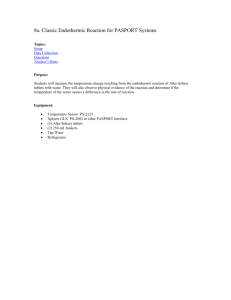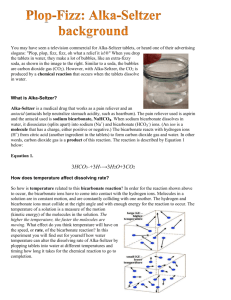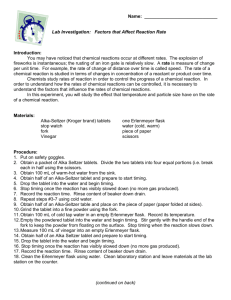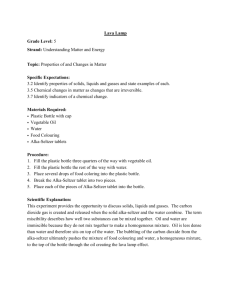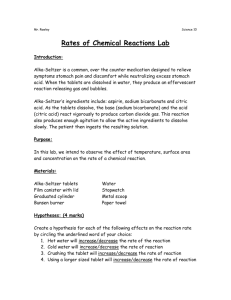What Influences Reaction Rate? (aka: The Relief Race) Dr. Ellen
advertisement
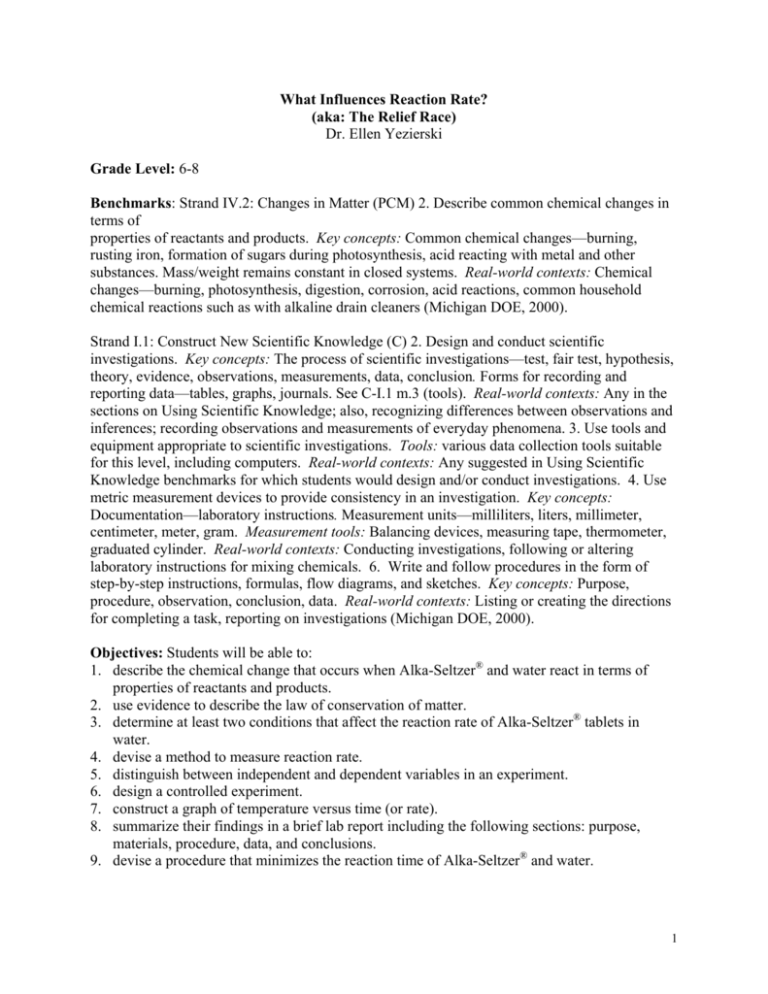
What Influences Reaction Rate? (aka: The Relief Race) Dr. Ellen Yezierski Grade Level: 6-8 Benchmarks: Strand IV.2: Changes in Matter (PCM) 2. Describe common chemical changes in terms of properties of reactants and products. Key concepts: Common chemical changes—burning, rusting iron, formation of sugars during photosynthesis, acid reacting with metal and other substances. Mass/weight remains constant in closed systems. Real-world contexts: Chemical changes—burning, photosynthesis, digestion, corrosion, acid reactions, common household chemical reactions such as with alkaline drain cleaners (Michigan DOE, 2000). Strand I.1: Construct New Scientific Knowledge (C) 2. Design and conduct scientific investigations. Key concepts: The process of scientific investigations—test, fair test, hypothesis, theory, evidence, observations, measurements, data, conclusion. Forms for recording and reporting data—tables, graphs, journals. See C-I.1 m.3 (tools). Real-world contexts: Any in the sections on Using Scientific Knowledge; also, recognizing differences between observations and inferences; recording observations and measurements of everyday phenomena. 3. Use tools and equipment appropriate to scientific investigations. Tools: various data collection tools suitable for this level, including computers. Real-world contexts: Any suggested in Using Scientific Knowledge benchmarks for which students would design and/or conduct investigations. 4. Use metric measurement devices to provide consistency in an investigation. Key concepts: Documentation—laboratory instructions. Measurement units—milliliters, liters, millimeter, centimeter, meter, gram. Measurement tools: Balancing devices, measuring tape, thermometer, graduated cylinder. Real-world contexts: Conducting investigations, following or altering laboratory instructions for mixing chemicals. 6. Write and follow procedures in the form of step-by-step instructions, formulas, flow diagrams, and sketches. Key concepts: Purpose, procedure, observation, conclusion, data. Real-world contexts: Listing or creating the directions for completing a task, reporting on investigations (Michigan DOE, 2000). Objectives: Students will be able to: 1. describe the chemical change that occurs when Alka-Seltzer® and water react in terms of properties of reactants and products. 2. use evidence to describe the law of conservation of matter. 3. determine at least two conditions that affect the reaction rate of Alka-Seltzer® tablets in water. 4. devise a method to measure reaction rate. 5. distinguish between independent and dependent variables in an experiment. 6. design a controlled experiment. 7. construct a graph of temperature versus time (or rate). 8. summarize their findings in a brief lab report including the following sections: purpose, materials, procedure, data, and conclusions. 9. devise a procedure that minimizes the reaction time of Alka-Seltzer® and water. 1 Materials and Setup Place two large containers (1-2 gallons) at the front of the room, one with very cold and the other with hot (but not boiling) water. Refill as needed. Each group of 3-4 students will need: 12 Alka-Seltzer® tablets (generic brands are less costly) 1 stopwatch (or clock with a second hand) 4 250-mL beakers or cups 4 500-mL beakers or cups 1 250-mL Erlenmeyer flask 1 200-mL graduated cylinder electronic balance (0.01 g precision or better) balloons 1 mortar and pestle 2-3 sheets of graph paper 1 metric ruler 1 stirring rod Safety Students should wear safety goggles at all times. The hot water should not be so hot that it burns skin (< 50°C). Remind students to handle glassware carefully. All liquid waste may be poured down the drain, and solid waste placed in the garbage. Save unused Alka-Seltzer® tablets for next time. Requisite Knowledge/skills for students Students should be familiar with metric units such as millimeters, centimeters, and milliliters. They should also know the basics of graphing, given x and y values. Procedure Engage: (10 minutes) Pass out the “Engage” worksheet. Pass around a few Alka-Seltzer® tablets. Ask students to carefully describe the tablet’s physical properties and write them down. Ask a few students to share what they wrote. Hold up a 250-mL beaker containing room temperature water and ask students to carefully describe the water’s physical properties. Drop the tablet in the water and ask students to describe what they see. Point out that the reaction shows a chemical property of Alka-Seltzer®. After the reaction is over, ask students to describe the physical properties of the products of the reaction and ask how they can distinguish between physical and chemical properties. Discuss their answers as a whole class. Tell students that they will be investigating what factors influence the rate at which the Alka-Seltzer® and water react. Ask students to discuss in their groups what is meant by rate and how they could measure it. Evaluate: Collect the worksheet as students begin Explore 1. Review the worksheets briefly checking for correctness. If most of the answers are incorrect, visit those students during Explore 1 and remediate as needed. Explore 1: (20 minutes) Pass out the “Explore” worksheet (attached). Students work in groups using the “Explore” worksheet and available materials to design an experiment to test the law of conservation of matter. Since one product of the reaction is a gas, they will likely decide to run the experiment with a balloon designed to capture the CO2. Students need to document their procedures and data. If students are struggling, remind them that the law of conservation of matter states that 2 matter cannot be created or destroyed during a chemical reaction. Ask students how they can measure the quantity of matter present at any time (mass). Evaluate: Observe students and determine if they figure out that they must capture the CO2. If they choose not to, you can discuss it with them individually or wait until their results are posted during Explain 1. Explain 1: (15 minutes) Ask the students to devise a scheme for reporting the class data. After they devise a scheme, have them put their results on the board. Ask the students to point out similarities among and differences between the various data sets. (It’s likely that no two sets will be alike, but most should have minimal differences between the mass of the reactants and products. Large differences in product and reactant masses could be due to not collecting the CO2 product.) Ask them if some of the data look strange and propose explanations for irregularities (experimental error). If the matter is conserved, why would there be a difference between the mass of reactants and the mass of products (assuming that students collected the CO2)? This is an opportunity to introduce uncertainty in measurement or at least to mention that the quality or “trueness” of measurements is dependent upon the instrument used to measure them and that NO measurement is exact. Evaluate: Students should write a paragraph responding to the following prompt: Our experiment violated the law of conservation of matter. Do you agree or disagree with this statement? Use your data or classmates’ data to support your conclusion. (A scoring rubric is attached.) Explore 2: (35 minutes) Students work in groups using the “Explore” worksheet (attached) and available materials to first decide what variables (factors) affect the rate of the reaction. A few variables they might explore include: size of tablet pieces (surface area), temperature of water, volume of water, size of container, stirring (or not), or the amount of reacted Alka-Seltzer® in the water. To help them get started, ask the following questions: What is meant by reaction rate? How would you know if a factor was somehow related to the rate of the reaction? How will you measure the reaction rate? It’s likely that students may not run controlled experiments at this point. You may wish to mention it here and assist them with their experimental design or wait until Explore 3. Evaluate (a): Review the group’s answer to question #2 on the Explore 2 worksheet. If their answer differs greatly from the following, remediate before they proceed with their experiment. Key: a. What is meant by reaction rate? (It is the speed at which the reaction proceeds.) b. How would you know if a factor was somehow related to the rate of the reaction? (A factor is related to reaction rate if changing the factor also changes the reaction rate or time.) c. How will you measure the reaction rate? (We will time the reaction from start to finish. Longer times mean slower reaction rates.) Evaluate (b): Observe student groups and determine which variables they are exploring. If a few groups have trouble generating variables (they only have 1 or 2), instruct them to speak with other groups. Explain 2: (20 minutes) Facilitate a class discussion by asking the following questions: What is meant by reaction rate (the speed at which a reaction proceeds)? How would you know if a factor was somehow related to the rate of the reaction (changing the factor in some way makes the reaction go slower or faster)? How will you measure the reaction rate (time the reaction from start to finish; shorter reaction times = faster reaction rates)? Ask students to list on the board the factors they 3 investigated. Be sure that if students do not list “rate or speed of reaction or reaction time,” add it to the list. Go down the list and ask the class to report on each factor as it pertains to their experiments: Did this affect the rate of the reaction? How did you know? After the students determine which factors affected reaction rate, introduce the following terms: variable (factor in experiment that is likely to change), independent variable, and dependent variable. Point out that the list they generated tells the variables in the experiments they conducted. Have the students classify the variables as dependent or independent. Explain that a controlled experiment involves changing or manipulating only one independent variable (sometimes called the experimental variable), keeping the other independent variables constant (controlled variables), and measuring the dependent variable (outcome variable). Students typically do not have a problem with this if you explain it in terms of fairness: Giving half the class more time on the test isn’t fair, because the time spent could be the independent variable affecting their scores (dependent variable) rather than their knowledge of the subject. Keeping the testing the conditions the same for all kids is like controlling variables. In the context of experimental design, we say: If we change more than one experimental factor (independent variable), we won’t know which one affected the outcome (dependent variable). Explore 3: (35 minutes) Ask the students to design a controlled experiment to determine the relationship between the temperature of the water and reaction rate of Alka-Seltzer® and water. To help them get started, ask them to identify the dependent and independent variables in the experiment, which variables they will hold constant (and how), which independent variable is their experimental variable (the one that they plan to change), how they will measure reaction rate (or reaction time), how they will measure temperature, and how they will ensure that their results are accurate. Require the students to run the experiment with at least 3 different water temperatures and multiple trials of each (time permitting). Students may need some help recognizing that they can mix the hot and cold water to obtain warm water samples. Hand out a blank transparency to each student group to record their data table to share with the class. Tell students that they should try to draw conclusions about the relationship between the temperature of the water and reaction rate of Alka-Seltzer® and water from their data. Evaluate: Collect one copy of the “Explore 3” worksheet from each group. Verify that the students properly identified the dependent and independent variables in the experiment (see “Explore 3” worksheet key.). Explain 3: (25 minutes) Each group will briefly present their data and preliminary conclusions. Students will likely say that the higher the temperature the faster the rate or the shorter the reaction time. Evaluate: Ask the presenters to describe how they ensured that their experiment was controlled. If their experiment was not controlled, ask them to discuss in their lab report how they would control variables if they did the experiment again. Tell students that looking at data tables sometimes reveals trends, but it’s often difficult to interpret numerical data. To remedy this, we often draw a picture of the data – make a graph. Pass out graph paper. At this point, you might choose to have the students work in their groups on their graphs or provide more direct instruction on the rules of graphing (at least half of the page, doesn’t have to start at (0, 0), increments must be evenly spaced, points should be small, axes labeled with quantity and unit, title required) selecting a scale, and plotting points, 4 depending on the math level of your students. Students should individually or in groups construct a graph of their data: Temperature versus Reaction Time or Temperature versus Reaction Rate (1/time). If students are familiar with line graphs, you can discuss the meaning of the slopes of their graphs and how the slope changes if their graphs are curved. If students do 4 or more temperatures, they will see how the temperature versus reaction time graph is a curve. Evaluate: Students prepare a laboratory report. See Lab Report Format and Rubric (attached). Elaborate (Apply, Extend): Reaction Race: In groups students devise a procedure that minimizes the reaction time of AlkaSeltzer® and water. Students will then prepare their water bath given the materials provided in the previous experiments and be given one Alka-Seltzer® tablet. They will line up their baths to “race” the tablets. It may be difficult to judge the winner if the tablets react very quickly; therefore the race may be modified such that students devise a procedure that maximizes the reaction time of Alka-Seltzer® and water, making the slowest rate the winner. Evaluate: Students take a quiz (attached). Evaluate: Detailed descriptions of data to collect and how they will be used to evaluate students are listed in various places in the Procedure section under “Evaluate.” These descriptions also refer to attached worksheets, rubrics, and a quiz. The types of student data to be collected in this lesson, the objective-assessment alignment, and the location of student evaluation criteria are summarized in the table below. Procedure Section Engage Explore 1 Explain 1 Explore 2a Explore 2b Explore 3 Explain 3 Explain 3 Elaborate Assessment Type Worksheet Observing students Paragraph Worksheet Observing students Worksheet Group presentation Lab report Quiz Objective(s) 1 2 2 4 3 5 6 6-8 9 Evaluation Criteria Worksheet key (attached) Refer to section Explore 1 Rubric (attached) Worksheet key (attached) Refer to section Explore 2a Worksheet key (attached) Refer to section Explain 3 Rubric (attached) Quiz key (attached) Scientific Background for the Teacher The main ingredients in Alka-Seltzer® are citric acid (C6H8O7), sodium bicarbonate or baking soda (NaHCO3), and acetylsalicylic acid or aspirin. The fizzing or effervescence is due to a reaction between the citric acid and sodium bicarbonate (Bayer, 2004). When the tablets are dropped into water, they dissolve and dissociate into ions as shown in the following equation: C6H8O7 (s) → 3H+ (aq) + C6H5O73- (aq) (Alternative notation: C3H5O(COO)33-) Sodium bicarbonate dissociates in water as shown in the following equation: NaHCO3 (s) → Na+ (aq) + HCO3- (aq) bicarbonate ion 5 When hydrogen ions and bicarbonate ions collide, they form carbonic acid (H2CO3). Carbonic acid readily decomposes to form carbon dioxide and water. The formation of the carbon dioxide produces the fizzing action. H+(aq) + HCO3-(aq) → H2CO3 (aq) → CO2(g) + H2O(l) Note that the reaction between carbonate and hydrogen ions can only occur if these ions are free to move in solution. This is why the reaction does not take place when the ingredients are mixed as solids to form the tables. In the solid, the hydrogen ion is bound to the citrate ion in the form of citric acid and the bicarbonate ion is bound to the sodium ion in the form of sodium bicarbonate or baking soda. The symbols in the balanced chemical equations describe the phase of each species: (s) = solid (l) = liquid (g) = gas (aq) = aqueous, in water solution Temperature (°C) Temperature (°C) The rate of a chemical reaction depends on a number of factors: temperature, particle size (surface area), concentrations of reactants, nature of the reactants, and the presence of a catalyst. Collision theory helps explain why these factors affect reaction rate. In order for a chemical reaction to occur, reactant particles (atoms, molecules, or ions) must collide with other reactant particles with sufficient energy and proper orientation such that a product can be formed. Increased temperature means that the average kinetic energy of the reaction system is increased, therefore increasing the energy of the particles. More energetic collisions increase the rate at which products are produced. Since the temperature increases the rate of the reaction, student graphs should look like these, depending on whether they graph time or rate on the x-axis: Time (s) Rate (s-1) By increasing the surface area of the reactants, more particles may collide and with the proper orientation, thus increasing the reaction rate. Higher reactant concentrations allow more reactant particles to collide in a given time, thus increasing the reaction rate. The nature of the reactants impacts the rate, since each chemical reaction has a different reaction pathway or series of intermediate products that form along the way. The slowest step in multi-step reactions determines the reaction rate. 6 Optional Lesson Components Misconceptions Although this lesson does not address chemical versus physical changes, this lesson does address the chemical change that occurs when Alka-Seltzer® and water react. Students are asked to describe this change in terms of the physical properties of reactants and products. The following misconceptions are relevant to the discussion and require the teacher to carefully use terms such as chemical reaction, chemical change, chemical property, and physical property to address this misconception if held by students: Formation of a new substance is not a characteristic of a chemical reaction, or the converse: chemical reactions are not characterized by the formation of a new substance (Ahtee & Varjola, 1999). Integration Between Science Disciplines The Constructing and Reflecting Benchmarks for this lesson apply to all science disciplines. Interdisciplinary Components Mathematics: The graphing portion of this lab could be extended to address topics such as Cartesian coordinates, plotting points, graph scales, x- and y- axes, and slope. Writing: In order for writing to be taught in this lesson, students must be given grammar, spelling, and mechanics feedback on their lab reports, be allowed to rewrite them, and then receive more feedback. Differentiation Grouping the students heterogeneously will allow the lower ability students to stay involved, although monitoring of the groups is necessary to ensure that all students are participating in the activities and understand the material. The mathematics components of this lesson allow higher math ability students an opportunity to use their algebra skills in interpreting data. References Ahtee, M. & Varjola, I. (1998). Students’ understanding of chemical reactions, International Journal of Science Education, 20, 303-316. Bayer Health Care (2004). Alka-Seltzer® Student Experiments: http://www.alkaseltzer.com/as/experiment/student_experiment.htm. Last accessed: July 14, 2005. Note: Similar experiments on reaction rate may be found here; however, this lesson was written authored without referring to such experiments. Michigan Curriculum Framework Science Benchmarks (2000). Michigan Department of Education: http://www.michigan.gov/documents/Updated_Science_Benchmarks_27030_7.pdf. Last accessed: July 14, 2005. 7 What Influences Reaction Rate? Name __________________ Engage 1. Carefully examine your Alka-Seltzer® tablets. In great detail, describe the tablet’s physical properties and write them down. Be prepared to share your observations with the rest of the class. 2. Describe the physical properties of the water. 3. Observe the reaction. Describe the physical properties of the products of the reaction. 4. How can we distinguish between the physical and chemical properties of a substance? 5. Discuss in your lab groups what is meant by reaction rate? Write a few notes. 6. How could you measure the rate of a chemical reaction? Write your ideas. 8 What Influences Reaction Rate? KEY Name __________________ Engage 1. Carefully examine your Alka-Seltzer® tablets. In great detail, describe the tablet’s physical properties and write them down. Be prepared to share your observations with the rest of the class. Tablet: solid, white, chalky, about 5 cm in diameter, disk shape, etc. (Students should have at least three characteristics.) 2. Describe the physical properties of the water. Water: liquid, colorless, transparent, less than a quart (or liter) in volume, reflects and refracts light (Students should have at least two characteristics.) 3. Observe the reaction. Describe the physical properties of the products of the reaction. Bubbles indicate that one product is a gas that’s colorless (pretty much invisible after they leave the liquid). Tablet appears to dissolve. If there is another product, it’s dissolved in the water. 4. How can we distinguish between the physical and chemical properties of a substance? Chemical properties require a chemical reaction to observe. Physical properties can be observed by the senses. Sometimes we change the matter physically to observe physical properties (eg., melting point, etc.). 5. Discuss in your lab groups what is meant by reaction rate? Write a few notes. Reaction rate refers to how fast (or the speed at which) the reactants change to products. 6. How could you measure the rate of a chemical reaction? Write your ideas. You could time the reaction from start to finish. The shorter the reaction time, the faster the reaction rate and vice versa. 9 What Influences Reaction Rate? Name __________________ Explore 1 Task: Design an experiment to test the law of conservation of matter using the reaction between Alka-Seltzer® and water. Materials: 12 Alka-Seltzer® tablets 1 stopwatch or clock 4 250 mL beakers or cups 4 500 mL beakers or cups 1 Erlenmeyer flask 1 200-mL graduated cylinder electronic balance balloons 1 mortar and pestle 2-3 sheets of graph paper 1 metric ruler 1 stirring rod hot water cold water 1. Write the law of conservation of matter. Use reference materials if needed. 2. Circle the materials you plan to use. Write a procedure for your experiment. Be sure to describe which measurements you plan to make and how you will make them. 3. Record your data. 10 What Influences Reaction Rate? KEY Name __________________ Explore 1 Task: Design an experiment to test the law of conservation of matter using the reaction between Alka-Seltzer® and water. Materials: 12 Alka-Seltzer® tablets 1 stopwatch or clock 4 250-mL beakers or cups 4 500-mL beakers or cups 1 250-mL Erlenmeyer flask 1 200-mL graduated cylinder electronic balance balloons 1 mortar and pestle (*see sample) 2-3 sheets of graph paper 1 metric ruler 1 stirring rod hot water cold water 1. Write the law of conservation of matter. Use reference materials if needed. Matter cannot be created or destroyed during a chemical reaction. 2. Circle the materials you plan to use. Write a procedure for your experiment. Be sure to describe which measurements you plan to make and how you will make them. *Sample answer: Add water to the flask and weigh the flask. Weigh three tablets and a balloon. Crush the tablets and dump them into the flask. Place the balloon over the flask. Shake the flask until the fizzing stops. Weigh the balloon and flask. (Note that the procedure includes critical steps, such as ensuring that the balloon is quickly placed onto the flask, but is not as clear as it could be. An important part of the procedure should be how to minimize error from not transferring all the ground tablets into the flask.) 3. Record your data. *Sample data: Mass of flask and water: 874.6 g Mass of balloon and tablets: 45.6 g (how many tablets?) Mass of balloon and flask: 915.8 (Note that units are not on all measurements and it’s not clear which items are included in each mass measurement.) 11 What Influences Reaction Rate? Name __________________ Explore 2 Task: Determine which variables or factors affect the rate of a reaction? 1. Given the materials available, what variables or factors could you test that might affect the rate of the reaction? List as many as you can. 2. To get started, think about the following questions: a. What is meant by reaction rate? b. How would you know if a factor was somehow related to the rate of the reaction? c. How will you measure the reaction rate? 3. Describe each variable you test, your results, and if your data suggest that the variable affects the reaction rate. 12 What Influences Reaction Rate? Name __________________ Explore 3 Task: Design a controlled experiment to determine the relationship between the temperature of the water and reaction rate of Alka-Seltzer® and water. 1. To get started, think about the following: a. What are the dependent and independent variables in the experiment? b. Which variables will you hold constant (and how)? c. Which independent variable is their experimental variable (the one that you plan to change)? d. How will you measure reaction rate (or reaction time)? e. How will you measure temperature? f. How will you ensure that their results are accurate? Note: You are required to run the experiment with at least 3 different water temperatures and multiple trials of each (time permitting). 2. Describe your procedure. 3. Record results here. You may wish to put your data in a table. 4. Try to draw conclusions about the relationship between the temperature of the water and reaction rate of Alka-Seltzer® and water from their data. 13 What Influences Reaction Rate? KEY Name __________________ Explore 3 Task: Design a controlled experiment to determine the relationship between the temperature of the water and reaction rate of Alka-Seltzer® and water. 1. To get started, think about the following: a. What are the dependent and independent variables in the experiment? b. Which variables will you hold constant (and how)? c. Which independent variable is their experimental variable (the one that you plan to change)? d. How will you measure reaction rate (or reaction time)? e. How will you measure temperature? f. How will you ensure that their results are accurate? Note: You are required to run the experiment with at least 3 different water temperatures and multiple trials of each (time permitting). 2. Describe your procedure. The following is not the procedure, but rather features of a quality procedure. The dependent variable should be reaction rate or time. The independent (and experimental) variable is the temperature of the water. Variables that students should hold constant: • Volume of water • Size of tablet • Stir (or not) • Manner in which timing is done (tablets are dropped in water in a consistent way) • Manner in which temperature of water is taken (touching the bottom or not; stirring thermometer or not; etc.) 3. Record results here. You may wish to put your data in a table. 4. Try to draw conclusions about the relationship between the temperature of the water and reaction rate of Alka-Seltzer® and water from their data. 14 Rubric for Paragraph in Explain 1 Assignment Category Answer to question Relationship to evidence and answer Grammar and spelling Excellent Agree or disagree is stated. (1) Specific evidence from experiment is given and it supports answer. (4) 1-2 minor errors (2) Acceptable Agree or disagree is stated. (1) Generalization from experiments is given and it supports answer. (2) 3-4 minor errors (1) Unacceptable Agree or disagree is not stated (0). Evidence given does not support answer or no evidence is given at all. (0) 5 or more errors (0) Format and Rubric for Lab Report Section Excellent Purpose Materials Procedure Data Conclusion Complete list of the materials and quantities used (3) Clear narrative describing experimental procedures carried out in chronological order with quantities of materials specified and how measurements were made. Dependent and independent variables are correctly identified as well as variables held constant. (4) Results presented in properly labeled tables. Graphs follow graphing rules. Measurements have units. Observations are clear and descriptive. (3) Clear and concise summary of findings that refers back to purpose and aligns with data. (2) Good Clear and concise statement of the reason for carrying out the experiment (3) Complete list of the materials used (2) Fair Fairly clear statement of the reason for carrying out the experiment (1) Mostly complete list of materials used (1) Poor The reason for carrying out the experiment is unclear (0) Very incomplete list of materials used (0) Mostly clear description of experimental procedures carried out in chronological order describing how measurements were made. Dependent and independent variables are correctly identified as well as some variables held constant. (3) Fairly clear description of experimental procedures carried out in mostly chronological order describing how measurements were made. Dependent and independent variables are correctly identified. (2) Narrative incomplete, unclearly written, and missing a description of variables. (0) Three of the four “excellent” criteria are met. (2) Two of the four “excellent” criteria are met. (1) Zero or one of the four “excellent” criteria are met. (0) Clear and concise summary of findings that refers back to purpose and aligns with data. (2) Unclear summary of findings that refers back to purpose and may align with data. (1) Unclear summary of findings that does not refer back to purpose. (0) 15 What Influences Reaction Rate Quiz Name __________________ Place a check next to each of following conditions that will increase the rate of Alka-Seltzer® reacting with water? __keep the container still __lower the water temperature __grind up the tablet __heat the water __put ice in the water __decrease the volume of water so it just covers the tablet __stir the water What Influences Reaction Rate Quiz KEY Name __________________ Place a check next to each of following conditions that will increase the rate of Alka-Seltzer® reacting with water? __keep the container still __lower the water temperature X grind up the tablet X heat the water __put ice in the water __decrease the volume of water so it just covers the tablet X stir the water 16

